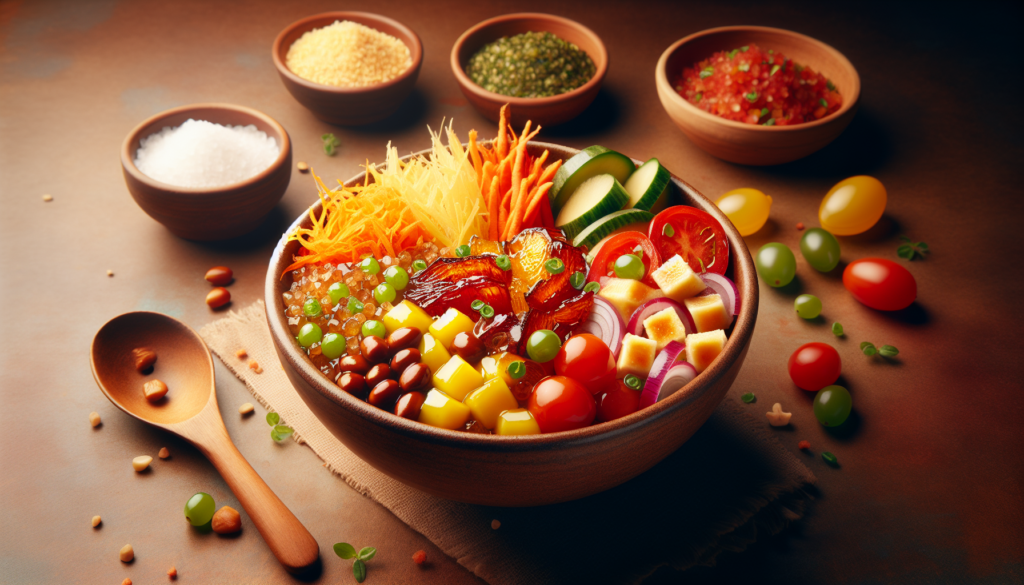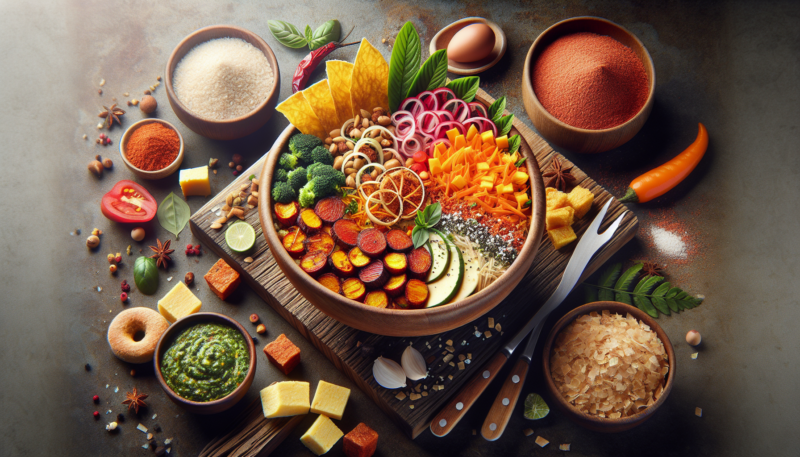Imagine indulging in a mouthwatering Brazilian dish that is not only delicious but also gluten-free. Introducing the tantalizing Gluten Free Vatapá recipe, a delightful combination of flavors that will take your taste buds on a tantalizing adventure. Bursting with rich ingredients and traditional cooking techniques, this dish is perfect for those craving the taste of Brazil without any gluten-based restrictions. Get ready to savor the vibrant flavors of Brazilian cuisine with this delightful recipe.
Ingredients
Vatapá is a traditional Brazilian dish that is both delicious and gluten-free. It is made using a variety of ingredients which give it its unique flavor and texture. Here are the ingredients you will need to make Vatapá:
1. Dried shrimp: Dried shrimp is a key ingredient in Vatapá as it adds a rich briny flavor to the dish. Before using the dried shrimp, it is important to soak them to rehydrate them and soften their texture.
2. Coconut milk: Coconut milk is used to give Vatapá its creamy and slightly sweet taste. It adds a tropical twist to the dish and pairs perfectly with the other ingredients.
3. Peanuts: Peanuts are another essential component of Vatapá. They add a nutty flavor and help to thicken the sauce. Make sure to use unsalted peanuts for the best results.
4. Onion: Onion provides a savory base to the dish and adds depth of flavor. It is typically chopped or minced and sautéed before adding the other ingredients.
5. Garlic: Garlic is a staple ingredient in many recipes and Vatapá is no exception. It adds a subtle yet distinctive taste to the dish.
6. Red bell pepper: Red bell pepper contributes a vibrant color and a slight sweetness to the dish. It is usually diced or sliced thinly to be incorporated into the sauce.
7. Palm oil: Palm oil is commonly used in Brazilian cuisine and is an essential ingredient in Vatapá. It imparts a rich, reddish color to the dish and adds a unique flavor.
8. Bread: Bread is used to thicken the sauce and give it a smooth and creamy consistency. It is typically torn into small pieces and added to the mixture.
9. Cashews: Cashews provide a crunchy texture and a hint of sweetness to complement the other flavors in Vatapá. They are usually toasted before being added as a topping or garnish.
10. Ginger: Ginger adds a subtle spiciness and warmth to the dish. It is typically grated or minced before being added to the sauce.
Preparation
To make Vatapá, you will need to follow several preparation steps to ensure the dish turns out perfectly. Here is a step-by-step guide on how to prepare Vatapá:
Soaking the dried shrimp: Start by soaking the dried shrimp in warm water for about 10-15 minutes. This will help rehydrate them and soften their texture, making them easier to blend later on.
Preparing the shrimp paste: Once the dried shrimp are soaked, drain them and blend them in a food processor or blender until they form a fine paste. This shrimp paste will be one of the key flavor enhancers in the dish.
Blending the ingredients: In a separate blender or food processor, combine the soaked shrimp paste, coconut milk, peanuts, onion, garlic, red bell pepper, palm oil, and ginger. Blend until smooth and well combined.
Cooking the mixture: Transfer the blended mixture to a large pot or saucepan and cook over medium heat. Stir constantly to prevent the mixture from sticking to the bottom of the pot.
Adding the coconut milk: Gradually pour in the coconut milk while continuing to stir the mixture. The coconut milk will add richness and flavor to the dish, balancing out the spices and other ingredients.
Simmering and thickening the sauce: Bring the mixture to a simmer and let it cook for about 15-20 minutes, stirring occasionally. This will allow the flavors to meld together and the sauce to thicken.
Adding the bread and nuts: Tear the bread into small pieces and add it to the pot. Stir well to incorporate the bread into the sauce. Then, sprinkle the cashews on top as a garnish.
Adjusting the consistency: Depending on your personal preference, you can adjust the consistency of the sauce by adding more coconut milk or bread. If you like a thicker sauce, add more bread; for a thinner sauce, add more coconut milk.
Serving and garnishing: Once the sauce has reached your desired consistency, it’s time to serve and garnish your Vatapá. Serve it warm with rice, plantains, or cassava flour. You can also garnish it with additional toasted cashews for added crunch.

Tips
To make the best Vatapá possible, here are some tips to help you along the way:
Choosing the right dried shrimp: When selecting dried shrimp, look for ones that are plump, intact, and have a fresh aroma. Avoid shrimp that appear discolored or have a strong fishy smell.
Using fresh coconut milk: For an authentic and flavorful Vatapá, it’s best to use fresh coconut milk. If you can’t find fresh coconut milk, opt for canned coconut milk with no additives or preservatives.
Serving suggestions: Vatapá is a versatile dish that can be served in various ways. It pairs well with steamed rice, plantains, or cassava flour. You can also enjoy it as a filling for acarajé, a traditional Brazilian street food.
Storing and reheating: Vatapá can be stored in an airtight container in the refrigerator for up to 3 days. When reheating, gently warm it on the stovetop over low heat to prevent scorching.
Variations
Vatapá is a versatile dish that can be customized to suit different dietary preferences and taste preferences. Here are some variations you can try:
Vegetarian or vegan option: To make a vegetarian or vegan version of Vatapá, simply omit the dried shrimp and use vegetable broth or water instead. You can also add more vegetables like diced carrots or zucchini for extra flavor and texture.
Spicy Vatapá: If you like a bit of heat, you can add a small amount of chili pepper or hot sauce to your Vatapá. Adjust the spiciness to your liking, but be careful not to overpower the other flavors.
Seafood Vatapá: For a seafood twist, you can add cooked shrimp, crabmeat, or fish to your Vatapá. Simply sauté the seafood separately and add it to the pot during the cooking process.

Gluten-Free Bread Options
If you’re following a gluten-free diet, there are several options available to replace regular bread in Vatapá. Here are some alternatives:
Gluten-free bread alternatives: Look for gluten-free bread at your local grocery store or specialty food store. There are many brands that offer gluten-free bread made from alternative flours like rice flour, almond flour, or tapioca starch.
Homemade gluten-free bread recipe: If you prefer to make your own gluten-free bread, there are plenty of recipes available online. You can experiment with different gluten-free flours and find a recipe that suits your taste and dietary needs.
Frequently Asked Questions
Here are some common questions about making Vatapá:
Can I use frozen shrimp instead of dried shrimp?
While dried shrimp are traditionally used in Vatapá, you can substitute them with frozen shrimp if you prefer. Just make sure to thaw and cook the shrimp before adding them to the dish.
Can I substitute palm oil with another oil?
Palm oil is a key ingredient in Vatapá and gives it its distinctive flavor and color. While you can use another oil like vegetable oil as a substitute, it will alter the taste and appearance of the dish.
Can I make Vatapá in advance?
Yes, you can make Vatapá in advance and store it in the refrigerator for up to 3 days. Simply reheat it on the stovetop before serving.
How long does Vatapá last in the fridge?
Vatapá can be refrigerated for up to 3 days. If stored properly in an airtight container, it should maintain its flavor and quality.
History of Vatapá
Vatapá is a dish with Afro-Brazilian origins and holds cultural significance in Brazilian cuisine.
Origins in Afro-Brazilian cuisine
Vatapá can be traced back to the West African roots of African slaves brought to Brazil during the colonial period. The dish is believed to have originated from the cuisine of the Yoruba people of Nigeria, who brought their culinary traditions to Brazil. Over time, Vatapá evolved and adapted to incorporate local ingredients and flavors.
Cultural significance
Vatapá is not only a delicious dish but also a symbol of African culture and heritage in Brazil. It is often served during religious and cultural celebrations, such as festivals honoring Afro-Brazilian deities. The dish has become an integral part of Brazilian cuisine, showcasing the diverse culinary influences that have shaped the country’s food culture.
Other Brazilian Dishes
Brazilian cuisine is known for its diverse flavors and vibrant dishes. Here are some other popular Brazilian dishes you might enjoy:
Feijoada
Feijoada is a hearty and flavorful black bean stew that is considered Brazil’s national dish. It typically includes a variety of meats such as pork, beef, and sausage, along with black beans and spices. It is traditionally served with rice, collard greens, and farofa (toasted cassava flour).
Pão de Queijo
Pão de Queijo, or cheese bread, is a popular Brazilian snack made with tapioca flour and cheese. The dough is rolled into small balls and baked until golden and crispy on the outside, with a soft and chewy texture on the inside. Pão de Queijo is enjoyed as a snack or served as an accompaniment to meals.
Coxinha
Coxinha is a savory snack that features a dough made from shredded chicken and cream cheese, shaped into a teardrop or drumstick shape, breaded, and deep-fried until crispy. It is a favorite snack at parties, festivals, and street food stalls in Brazil.
Brigadeiro
Brigadeiro is a beloved Brazilian sweet treat made from condensed milk, cocoa powder, butter, and chocolate sprinkles. It is rolled into bite-sized balls and often served at birthday parties and celebrations. Brigadeiro has a rich and fudgy texture, making it a must-try for those with a sweet tooth.
Moqueca
Moqueca is a traditional Brazilian seafood stew made with fish, shrimp, or other seafood, cooked in a flavorful broth with coconut milk, tomatoes, peppers, onions, and various spices. It is typically served with rice and farofa. Moqueca is popular in coastal regions of Brazil and showcases the country’s love for fresh seafood.
Acarajé
Acarajé is a street food specialty originating from the northeastern state of Bahia in Brazil. It is a deep-fried ball of black-eyed pea dough stuffed with a filling of shrimp, vatapá, and various condiments. Acarajé is not only a delicious snack but also an important part of Afro-Brazilian culture and cuisine.
Conclusion
Vatapá is a delicious and gluten-free dish that offers a taste of the rich culinary traditions of Brazil. With its creamy texture, briny flavor, and customizable ingredients, Vatapá is a versatile dish that can be enjoyed by everyone. Whether you’re following a gluten-free diet or simply looking to explore the diverse flavors of Brazilian cuisine, Vatapá is a must-try dish that will delight your taste buds. So gather the ingredients, follow the step-by-step instructions, and savor the flavors of this authentic Brazilian delicacy.
